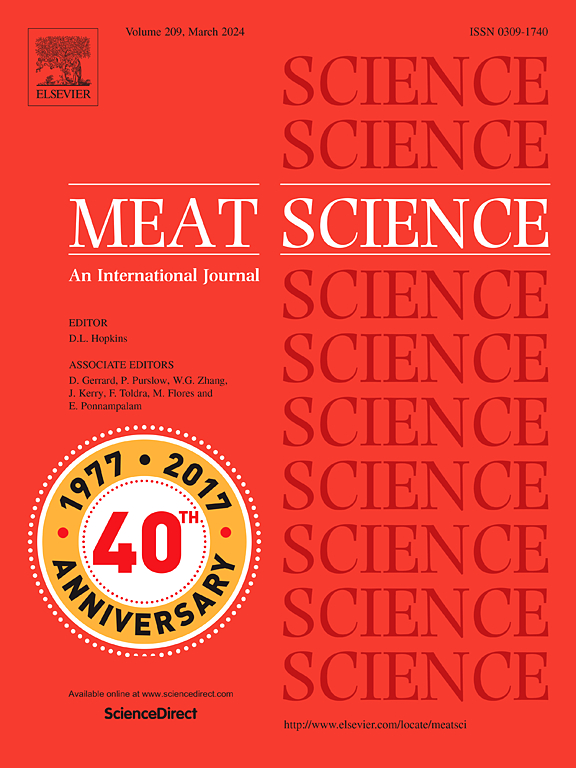通过非靶向代谢组学阐明湿老化牛肉风味和嫩度表型
IF 6.1
1区 农林科学
Q1 Agricultural and Biological Sciences
引用次数: 0
摘要
本研究的目的是表征牛肉腰最长肌(LL)和分泌物(EX)的代谢组学变化,并评估基于牛肉风味和嫩度表型的代谢组学变化。牛里脊肉接受了老化温度(- 2、0或4°C)和持续时间(14、28、42和56 d)方案。用80%的甲醇从速冻、均质的LL和EX样品中提取代谢物。代谢物的衍生化通过甲氧基化和硅基化进行,并通过气相色谱-质谱分析。切片剪切力,蛋白水解活性(聚乳酸蛋白和肌钙蛋白-t),游离氨基酸和描述性感官分析也进行了。聚类分析用于产生嫩度和风味表型组。LL代谢组容易受到衰老时间的影响,引起氨基酸、多肽、碳水化合物、生物胺和核苷酸/核苷的变化(FDR P <;0.05)。观察了EX (FDR P <)中烟酸、甘油三酯+塔格糖和色胺的老化温度与老化时间的相互作用。0.05)。聚类分析结果显示,牛肉嫩度和风味分别有3个和4个表型聚类。柔嫩III期的特征是SSF增加,蛋白水解活性降低,这与碳水化合物的丰度一致(FDR P <;0.05)。风味IV具有增加的异味强度,这与生物胺,风味活性氨基酸和有机酸的增加相对应(FDR P <;0.05)。总的来说,这项研究表征了衰老过程中牛肉代谢组的变化。突出嫩度和风味的分子表型,以及渗出物监测牛肉质量的潜力。本文章由计算机程序翻译,如有差异,请以英文原文为准。
Elucidation of wet aged beef flavor and tenderness phenotypes via untargeted metabolomics
The objective of this study was to characterize metabolomic changes in beef M. longissimus lumborum (LL) and exudate (EX) and to evaluate metabolomic shifts based on beef flavor and tenderness phenotype. Beef strip loins were subjected to aging temperature (−2, 0, or 4 °C) and duration (14, 28, 42, and 56 d) regimens. Metabolites were extracted from snap frozen, homogenized LL samples and EX samples using 80 % methanol. Derivatization of metabolites was conducted via methoximation and silylation and analyzed by gas chromatography–mass spectrometry. Slice shear force, proteolytic activity (desmin and troponin-t), free amino acids, and descriptive sensory analysis were also conducted. Agglomerative hierarchical cluster analysis was used to produce tenderness and flavor phenotype groups. The LL metabolome was readily influenced by aging duration, eliciting changes in amino acids, peptides, carbohydrates, biogenic amines, and nucleotides/nucleosides (FDR P < 0.05). An aging temperature × aging duration interaction was observed for nicotinic acid, psicose+tagatose, and tryptamine in EX (FDR P < 0.05). Agglomerative hierarchical cluster analysis resulted in 3 and 4 phenotypic clusters for beef tenderness and flavor, respectively. Tenderness III was characterized by increased SSF and decreased proteolytic activity which coincided with an abundance of carbohydrates (FDR P < 0.05). Flavor IV possessed increased off-flavor intensity which corresponded to an increase of biogenic amines, taste-active amino acids, and organic acids (FDR P < 0.05). Overall, this study characterizes changes in the beef metabolome during aging. Highlights the molecular phenotype of tenderness and flavor, and the potential of exudate to monitor beef quality.
求助全文
通过发布文献求助,成功后即可免费获取论文全文。
去求助
来源期刊

Meat Science
工程技术-食品科技
CiteScore
12.60
自引率
9.90%
发文量
282
审稿时长
60 days
期刊介绍:
The aim of Meat Science is to serve as a suitable platform for the dissemination of interdisciplinary and international knowledge on all factors influencing the properties of meat. While the journal primarily focuses on the flesh of mammals, contributions related to poultry will be considered if they enhance the overall understanding of the relationship between muscle nature and meat quality post mortem. Additionally, papers on large birds (e.g., emus, ostriches) as well as wild-captured mammals and crocodiles will be welcomed.
 求助内容:
求助内容: 应助结果提醒方式:
应助结果提醒方式:


